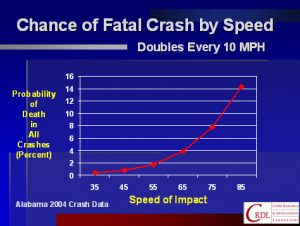 TUSCALOOSA, Ala. – The holiday weeks, beginning with Thanksgiving, historically have been among the deadliest times to be on the road, and speed is a major factor according to a University of Alabama study.
TUSCALOOSA, Ala. – The holiday weeks, beginning with Thanksgiving, historically have been among the deadliest times to be on the road, and speed is a major factor according to a University of Alabama study.
“Our studies, using Alabama crash data collected by the Alabama Department of Public Safety, have shown that the probability of any crash being fatal doubles with every additional ten miles per hour of impact speed,” said Dr. Allen Parrish, professor of computer science and director of UA’s CARE Research & Development Laboratory.
Dr. David Brown, professor of computer science and director of development of UA’s CRDL, recently presented these findings at the Alabama Traffic Safety Summit that was held in Montgomery. (See attached chart for further information about the correlation of speed and fatalities.)
“What this means is that if we could, on average, reduce the speeds by ten miles per hour, we could cut our fatalities in half,” explained Parrish. “Even a five mile per hour reduction can result in a major increase in survivability.”
Parrish urged drivers to decelerate away from dangerous situations and put as much distance as you can from heavy trucks.
“There is no reason that a car cannot decelerate away from a truck. Our studies have shown clearly that in fatal car-truck crashes, the car is at fault a clear-cut majority of the time,” said Brown. “The reduction in speed to put a little distance between you and a truck will not make you one minute later in arrival.”
UA’s traffic safety studies also have found the days before Thanksgiving to be high-crash days because of the mix of heavy business, shopping and vacationer traffic. While the days between Christmas and New Years have fewer crashes, they tend to be more severe because of the increased use of alcohol during that period.
“Every day during this time period tends to have the characteristics of a weekend day,” said Parrish.
Parrish advised against being out on the road at times when people will typically be drinking.
“I think we all know when these times are. Typically, they are weekends, but during the holidays they will be all of the nights before days when a large number of people have the day off. Avoiding these times is the only way to be sure you protect yourself from being the victim of a drunk driver,” Parrish stated.
Parrish noted that some of the best times to be on the road are during the holidays themselves, when the roads are almost totally deserted.
“We have found a strong correlation in all forms of risk-taking behavior, so many of these late night crashes involve alcohol, speed, lack of restraint use, and they often occur in rural areas that are difficult to reach quickly with Emergency Medical Services,” explained Parrish.
Knowing the cause makes it fairly easy to cut your probability of being killed in a car crash to almost zero. The recommendations given by UA’s CARE Research & Development Laboratory are quite simple to follow:
- Never drink and drive, or ride with anyone who has even had a single drink.
- Avoid times when drinking drivers are apt to be on the road.
- Observe all speed limits and warning signs, and back-off from dangerous situations.
- Always wear restraints, and keep your children in their restraints.
UA’s CARE Research & Development Laboratory uses leading edge technologies to offer products and specialized software development services in a variety of areas, particularly traffic safety and law enforcement. The CARE software developed at CRDL has been implemented in nine states for traffic records analysis. CRDL has designed an electronic citation application for use by law enforcement officers in the state of Alabama. Additionally, the CRDL routinely provides a variety of safety studies and planning documents, such as the Crash Facts Books and Highway Safety Plans that are available on their web site at http://care.cs.ua.edu.
Contact
Mary Wymer, Engineering Media Relations, 205/348-6444, mwymer@eng.ua.edu
Source
Dr. Allen Parrish, 205/348-3749, parrish@cs.ua.edu.